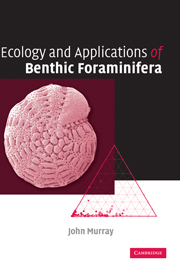Book contents
- Frontmatter
- Contents
- Preface
- 1 Introduction
- 2 Methods
- 3 Aspects of biology and basic ecology
- 4 Marginal marine environments
- 5 Shelf seas
- 6 Carbonate environments
- 7 Deep sea
- 8 Summary of living distributions
- 9 Taphonomic processes: formation of dead and fossil assemblages
- 10 Applications
- Glossary
- Appendix
- References
- Taxonomic Index
- General Index
8 - Summary of living distributions
Published online by Cambridge University Press: 12 August 2009
- Frontmatter
- Contents
- Preface
- 1 Introduction
- 2 Methods
- 3 Aspects of biology and basic ecology
- 4 Marginal marine environments
- 5 Shelf seas
- 6 Carbonate environments
- 7 Deep sea
- 8 Summary of living distributions
- 9 Taphonomic processes: formation of dead and fossil assemblages
- 10 Applications
- Glossary
- Appendix
- References
- Taxonomic Index
- General Index
Summary
Introduction
In general, no attempt has been made in Chapters 4–7 to account for species distributions except in a very general way. The aim of this chapter is to summarise important spatial and temporal patterns of species and assemblage distributions based on field surveys and to comment on possible ecological controls.
Major new findings
There is increasing awareness that, unlike physical or chemical systems, biological systems are not well ordered. This is undoubtedly due to their complexity and to the multiplicity of interactions that affect living organisms. From the niche concept we can understand that at any one locality it is the parameter (or parameters) close to the limit of tolerance that limit the local distribution of a species; it follows that for any one species different parameters limit its distribution at different times and in different places. Benthic foraminifera have been shown to be more mobile than we previously thought and even supposedly attached epifaunal forms can move around (see Section 3.2.8). Infaunal taxa do not show consistent depth stratification either spatially or temporally because they respond to local geochemical conditions in the sediment. Foraminifera are more tolerant of oxygen depletion than most macrofauna and other meiofauna and some hard-shelled taxa can tolerate periods of anoxia of at least two months. There is a general correlation between the availability of food (flux of Corg) and species abundance, at least at water depths greater than about 1000 m.
- Type
- Chapter
- Information
- Ecology and Applications of Benthic Foraminifera , pp. 238 - 264Publisher: Cambridge University PressPrint publication year: 2006



